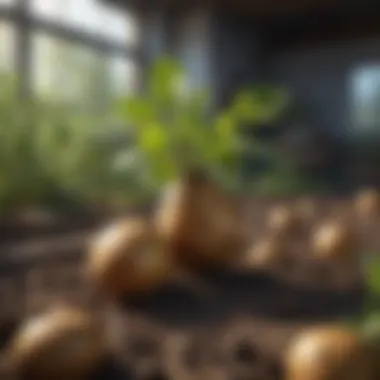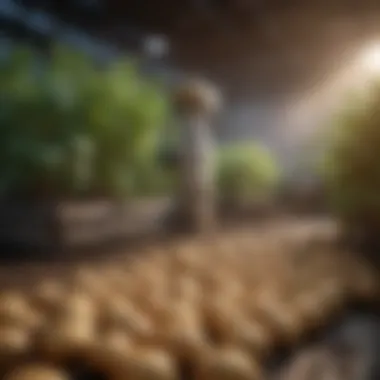Effective Prevention Strategies for Potato Blight


Intro
Potato blight, caused mainly by the Phytophthora infestans pathogen, presents a formidable challenge for those growing this staple crop. The rampant nature of this disease can devastate entire harvests, making it imperative for gardeners and farmers to adopt preventive strategies diligently. Understanding the biology of the pathogen and the environmental factors conducive to its spread is crucial for mitigating its impact effectively.
In this article, we will dissect various prevention strategies tailored to combat potato blight. We'll delve into the core aspects—examining cultural practices, chemical control methods, and responsive measures to maintain healthy potato plants. This detailed guide serves not only to root awareness but also equips horticulturists and dedicated gardeners with the knowledge needed for sustainable agricultural productivity.
By taking a proactive stance against potato blight, one can certainly improve yield potential and streamline the path toward more fruitful cultivation. Let’s grow deeper into this subject!
Understanding Potato Blight
Potato blight, primarily instigated by the pathogen Phytophthora infestans, poses a severe threat to potato crops across the globe. Understanding this disease is not just for the informatoin of farmers but also for anyone interested in horticulture or even the culinary aspects of potatoes. The repercussions of a blight outbreak aren’t limited to farmers; they ripple through to consumers, fulfilling an important role in our food system. This section unpacks the essential knowledge around potato blight, elaborating on its definition, lifecycle, and recognizable symptoms. Grasping these elements is crucial in developing effective prevention strategies to combat this agricultural menace.
Definition and Impact
Potato blight refers to a disease that affects potato plants, causing fungal decay and destruction of the foliage, stems, and tubers. Its impact is notably devastating; it can obliterate entire fields within days if conditions are conducive to the pathogen's proliferation. The economic consequences are immense, driving up prices for consumers and reducing yield for growers. Notably, the Great Famine in Ireland in the mid-19th century serves as a stark reminder of the destructive potential of this blight, along with its deep-seated ramifications in society.
The Life Cycle of Phytophthora Infestans
To effectively fend off potato blight, one has to understand the life cycle of Phytophthora infestans. This microorganism spreads primarily through moist conditions where spores can thrive:
- Spores: The cycle begins with the release of sporangia from infected plant material.
- Wind and Water: These spores can travel via wind or water, infecting healthy plants.
- Infection: Upon landing on a leaf, the spores germinate when environmental conditions are suitable—generally, this requires moisture and favorable temperatures.
- Signs of Spread: Once established, the organism proliferates and continues to produce spores, leading to further spread.
Understanding this cycle is paramount. Preventive measures can be tailored for each stage, from managing spore spread to altering cultivation practices.
Symptoms to Recognize
Recognizing potato blight early on is vital in mitigating its effects. Common symptoms include:
- Wilting Leaves: The leaves may appear droopy and wilted due to the disease's impact on the vascular system.
- Dark Spots: Look for dark brown or purplish spots on the leaves, often surrounded by a lighter halo. This is a clear indication of infection.
- Blackened Stems: Stems may turn dark brown or black, which impacts the plant's overall structural integrity.
- Rotting Tubers: Infected tubers can develop soft rot, noted by a foul smell and a mushy texture.
Early detection is key. Recognizing these signs and symptoms promptly can help in managing the blight before it takes a toll on the entire crop.
Environmental Conditions Favoring Blight
Understanding the environmental factors that contribute to potato blight is crucial for effective prevention strategies. Blight thrives under specific conditions, and by being aware of these, farmers and gardeners can take steps to mitigate risks. Two significant elements to consider are temperature and humidity, as well as wetness duration and foliar splash. These aspects not only influence the pathogen's spread but also help in creating an integrated management approach.
Temperature and Humidity
Temperature and humidity have a profound effect on the proliferation of Phytophthora infestans, the main culprit behind potato blight. Ideally, this fungus flourishes when temperatures hover between 60°F to 70°F (approximately 15°C to 21°C). Beyond this range, particularly in warmer environments, the severity of blight may decline. However, the fishy scent of a warm, humid day can escalate the appearance of this disease. High levels of humidity—around 85% and above—create the perfect storm for blight to spread.
Gardening enthusiasts may find it beneficial to monitor and regulate these conditions. For instance:
- Change in control practices: If you’re growing potatoes in a particularly humid region, consider strategies like creating better airflow between plants.
- Soil management: Light tilling can reduce moisture retention, discouraging blight spores from establishing.
- Growing period: An understanding of seasonal weather trends can help in planting earlier or later in the season, thereby dodging conditions that favor blight.
Wetness Duration and Foliar Splash
Wetness plays an instrumental role in the life cycle of Phytophthora infestans. Excess moisture on leaves—resulting from rain or dew—along with the splash from soil, provides a conducive environment for infection. It’s essential to note that the longer the leaves stay wet, the greater the risk of disease. The fungus can be spread easily through water droplets on leaves and soil, exacerbating an already dire situation.


Managing this risk involves the following practices:
- Timely irrigation: Watering should be done early in the day, allowing foliage to dry by evening. This simple act can dramatically reduce wetness duration overnight.
- Mulching: This preserves soil moisture but also helps keep foliage dry by preventing soil from splashing onto plants during rain.
- Plant residue management: Keeping an eye on plant debris from previous seasons can significantly prevent blight pathways since the pathogen can survive in leftover plant material.
"Understanding environmental conditions is half the battle in preventing potato blight; planning around them can save your harvest."
By being proactive and informed about these environmental factors, you're better positioned to fend off potato blight effectively. Taking control of the situation through mindful practices can make a world of difference when it comes to maintaining healthy potato crops.
Cultural Practices for Prevention
The significance of cultural practices in preventing potato blight cannot be overstated. These practices encompass methods that promote healthier crop growth while minimizing conditions conducive to the disease’s spread. By employing good cultural strategies, farmers and gardeners alike can significantly reduce the risk of infection and, ultimately, improve yields. Let’s delve deeper into some of the most effective cultural practices.
Crop Rotation Techniques
One of the cornerstone strategies in managing potato blight is crop rotation. The essence of this technique lies in changing the type of crops grown in a particular area each season.
Potatoes belong to the Solanaceae family, so rotating them with crops from different families, such as legumes or grains, can disrupt the life cycle of the Phytophthora infestans pathogen. For instance, planting peas or beans in an area previously occupied by potatoes could help starve the blight pathogen due to its inability to thrive on these unrelated plants. Rotating crops reduces the build-up of pathogens in the soil while enhancing soil fertility, leading to a more resilient farming system.
"Effective crop rotation can break disease cycles while restoring nutrient levels in the soil, making it a win-win for growers."
Choosing Resistant Varieties
Selecting resistant potato varieties is another impactful practice. Not all potato varieties react the same way to disease; some are bred specifically to withstand certain pathogens, including the ones responsible for blight. Utilizing these resistant varieties can substantially reduce the likelihood of infection.
For example, potatoes like 'Defender' or 'Russet Burbank' have shown excellent resistance to blight. Beyond just the choice of variety, it's imperative to source certified seed potatoes to ensure they are free of disease. The benefits are twofold: you not only mitigate risk but also often enjoy higher crop yields and better-quality tubers.
Proper Spacing and Irrigation
Another crucial aspect of prevention is ensuring proper spacing between plants. Dense planting can create an environment ripe for the spread of pathogens. Adequately spaced potato plants have better air circulation, which helps reduce humidity levels around the foliage—a critical factor in controlling blight proliferation. As a rule of thumb, aim for a distance of about 12-15 inches between plants.
Proper irrigation techniques also play a significant role. Overhead watering can cause excessive moisture on leaves and promote the spread of blight. Instead, adopting a drip irrigation system can deliver water directly to the roots while keeping the foliage dry. This not only conserves water but also minimizes disease risk. Managing soil moisture levels through thoughtful irrigation and mulching is crucial for maintaining plant health.
Chemical Control Measures
In the realm of potato cultivation, addressing the persistent threat of blight requires a multifaceted approach, and chemical control measures stand as a pillar of this strategy. These measures are essential for curtailing the spread of Phytophthora infestans, the fungal adversary responsible for this disease. When properly integrated with cultural practices, chemical controls can significantly mitigate the impact of blight, safeguarding both yield and quality of tubers.
Fungicide Options
Selecting the right fungicides is crucial for effective blight management. There are several active ingredients that have shown efficacy against this pathogen, including:
- Metalaxyl: This systemic fungicide is absorbed through the plant's roots and foliage, effectively treating and preventing infections.
- Mefenoxam: Similar to Metalaxyl, it acts quickly against early infections, making it a popular choice during high-risk periods.
- Chlorothalonil: A broad-spectrum fungicide, it provides preventive action and is effective in controlling numerous foliar diseases.
Utilizing a combination of these fungicides can help prevent resistance development. Mixing products with different modes of action is advisable. Just like a good recipe needs various ingredients, so does a spraying regimen need diversity for optimal results.
Application Timing and Techniques
Timing is everything when it comes to applying fungicides. Here’s what to keep in mind:


- Early Application: Begin treatments before foliage becomes infected. Applying fungicides during periods of high humidity or after rainfall can prevent disease establishment.
- Regular Intervals: Reapplications are often necessary, particularly during wet conditions. Following the label recommendations for reapplication intervals ensures that the plants maintain protective coverage.
- Weather Conditions: Aim for calm days to minimize drift and enhance coverage. Additionally, applying in the morning can reduce the risk of evaporation during hot afternoons.
Adopting techniques that optimize spray coverage, like utilizing airblast sprayers or ensuring even application from ground-based equipment, can also improve efficacy significantly.
"Effective chemical control requires not just good products, but good timing and technique too."
By adhering to these strategies, potato growers can keep a tight lid on blight outbreaks, providing their crops with a shield against this relentless foe. Remember, while chemical controls are effective, they should not be the sole weapon in the arsenal against blight. Integrating these measures with sound cultural practices can lead to comprehensive disease management that embraces sustainability and productivity.
Monitoring and Early Detection
Keeping a vigilant eye on potato crops is crucial in the fight against potato blight. Early detection of symptoms and understanding the right monitoring practices can save tons of harvested potatoes and ultimately impact the bottom line for growers. When it comes to preventing disease, an ounce of prevention is worth a pound of cure. Here’s a deeper dive into the significance of monitoring and early detection in combating this relentless foe.
Field Surveillance Practices
Field surveillance isn't just checking the plants now and then; it's an ongoing commitment. Farmers and gardeners should routinely inspect their potato plants, especially during the early growing season when the plants are more vulnerable to infection.
Key Practices:
- Regular Inspections: Conduct visual assessments at least once a week. Look for tell-tale signs like dark patches or wilting leaves, which can indicate the possibility of blight developing.
- Use of Traps: Set up traps with a sugary bait that attract insects which could be vectors for spreading pathogens. Checking these traps gives insight into the environmental risk factors present.
- Alert Systems: Implement a notification system using apps or local agricultural extension services. They can provide alerts on blight outbreaks in the area and track risk factors like increased moisture.
One effective way to ensure thorough monitoring is to involve community efforts. Forming groups of local gardeners or farmers can offer diverse insights and shared resources, allowing team-based vigilance against potato blight, tapping into collective knowledge.
"Prevention through monitoring is like having an early warning radar at sea; it helps you avoid storms before they hit."
Recording Environmental Data
The next piece of the puzzle involves recording environmental data. Detailed records can help identify patterns and can assist in predictive modeling, allowing for proactive measures rather than reactive solutions.
Here’s how to keep track:
- Temperature Monitoring: Install simple thermometers or use weather station plugins to monitor day and night temperatures. Phytophthora infestans thrives under specific temperature ranges (optimum between 60 to 70°F), so even minor changes can be pivotal.
- Humidity Levels: Keeping an eye on local humidity can also signal potential blight conditions. A perception of increased humidity in the range of 75% or higher can warrant immediate action.
- Precipitation Logs: Records of rainfall duration and intensity can be invaluable in tracking conditions conducive to blight growth. This data can then inform irrigation practices that minimize wet foliage, reducing the potential for disease.
In summary, the foundation of effective prevention strategies lies in consistent monitoring and data collection. Not just for potato blight, but for the overall well-being of every crop. This knowledge empowers growers and enables them to take informed, timely action to protect their valuable crops from this persistent threat.
Integrating Sustainable Practices
Incorporating sustainable practices into the prevention of potato blight deals with more than just tackling the immediate threat. It emphasizes cultivating a farming approach that is respectful of natural ecosystems and encourages practices that lead to healthier soils, resilient crops, and ultimately, sustainable productivity. Using sustainable methods not only lessens reliance on chemical treatments but also fosters biodiversity, making the environment less hospitable to pathogens such as Phytophthora infestans.
Utilizing Organic Control Options
Organic control options are a cornerstone of sustainable practices for managing potato blight. These strategies revolve around utilizing natural substances and methods rather than synthetic chemicals, aiming to enhance plant health and reduce disease susceptibility.
- Neem Oil: Extracted from the seeds of the neem tree, neem oil is known for its antifungal properties. This organic compound can deter infections when applied preventively.
- Copper-Based Sprays: While some may be concerned about copper accumulation in soils, using it responsibly as a targeted response to blight can be effective. Copper forms a protective layer that reduces fungal infection chances.
- Biological Fungicides: Products like Trichoderma, a beneficial fungus, can outcompete harmful pathogens and promote healthy soil microbiomes.
Using these methods, farmers can shift towards a more integrated approach, improving soil health and creating a balanced ecosystem that minimizes the likelihood of disease outbreaks.
Biodiversity and Companion Planting


Another layer to building resilience against potato blight lies in promoting biodiversity through companion planting. This technique allows various crops to coexist, offering several benefits that contribute to disease prevention.
- Companion planting reduces common blight hosts: Certain plants, such as marigolds, naturally repel pests and diseases, helping safeguard potatoes against potential blight initiation.
- Diversity encourages beneficial insects: By planting a mix of crops, you can attract a variety of beneficial insects that prey on potential threats to the potato plant.
- Nutrient sharing: Different plants have varying nutrient needs and soil adaptations, which can maintain soil health and fertility without the added use of fertilizers.
"A diverse garden is a happy garden; it keeps diseases at bay and creates a robust ecosystem."
Integrating these sustainable practices not only supports current potato cultivation but also paves the way for farming methods that soil health thrives. Understanding how to work with nature, rather than against it, is paramount in cultivating a successful agricultural future.
Case Studies of Successful Prevention
Understanding case studies in the realm of potato blight prevention offers practical insights that intertwine theory with real-world experience. These studies highlight methods and innovations that have proven effective, serving as a beacon for both commercial farmers and home gardeners. By analyzing specific examples, we can glean important lessons on effective strategies, as well as the challenges and successes involved in combating this persistent threat to potato crops.
Innovative Practices in Commercial Farming
In the commercial arena, farms often face immense pressures from both market demands and environmental challenges. One notable example can be found in a large-scale potato farm in Idaho. This farm adopted a multi-faceted approach by focusing on integrating technology with traditional farming methods. They have successfully used drone technology to monitor crop health.
Drones equipped with spectral cameras can assess plant health instantly, spotting areas that may be stressed or predisposed to blight. Once detected, farmers can take immediate action, such as adjusting irrigation methods or applying targeted treatments, rather than awaiting visible signs of disease.
Another commendable strategy utilized by commercial growers includes the enhancement of crop rotation practices. Rather than sticking to a standard rotation, some farms explore a more diversified planting schedule. For instance, incorporating legumes in the rotation not only allows nitrogen replenishment in the soil but also interrupts the lifecycle of pathogens.
The results of these practices have demonstrated a marked reduction in potato blight occurrences, giving these farms an edge in production and sustainability.
Small-Scale Garden Success Stories
On the other end of the spectrum, small-scale gardeners often face different challenges and limitations, but they too have found innovative ways to combat potato blight. Take for example a community garden project in Oregon, which rallied local residents to implement a collective strategy. They focused on biodiversity through companion planting. By introducing marigolds and basil alongside potato plants, they noticed fewer infections of potato blight. The strong scent of marigolds, in particular, acted as a natural deterrent to pests which may carry the pathogens.
Additionally, this community garden stressed the importance of improved sanitation practices such as proper disposal of diseased plant material and thorough cleaning of tools. Such practices reduced blight spreads significantly and made their efforts collective rather than individual.
These small gardens might not have the expansive resources of large farms, but they demonstrate the power of community efforts and sustainable practices, proving that with imagination and diligence, successful prevention strategies can thrive at every scale.
"Real change often begins at the grassroots level, demonstrating that whether in a commercial growing operation or a small garden, disease management can be approached creatively and effectively."
Through the lens of these real-case scenarios, it becomes clear that both innovative techniques in commercial farming and community-led efforts in small gardens contribute vital knowledge essential for preventing potato blight, broadening the perspective on what successful prevention can look like.
Finale and Future Directions
In wrapping up this examination of strategies to prevent potato blight, it's essential to reflect on the broader implications for not just individual gardeners or farmers, but for the agricultural community as a whole. Effective prevention is not merely about saving crops; it’s about ensuring food security, economic stability for those who depend on potato farming, and sustaining the land for future generations.
Summarizing Prevention Strategies
The prevention of potato blight involves a multifaceted approach. Here are the key strategies distilled from our exploration:
- Understanding the Pathogen: Familiarizing oneself with the Phytophthora infestans disease cycle equips growers with the knowledge necessary to anticipate and mitigate outbreaks.
- Environmental Management: Monitoring temperature and humidity, alongside wetness duration, is crucial. Implementing drainage solutions can reduce moisture retention, particularly in fields prone to flooding.
- Cultural Practices: Employing crop rotation with non-susceptible crops can disrupt the lifecycle of the pathogen. Additionally, selecting resistant potato varieties and practicing proper spacing can reduce the chances of infection.
- Chemical Controls: The judicious use of fungicides, when timed appropriately, can offer a safety net for crops. It is crucial, however, to integrate these practices sustainably, considering their long-term impact on the ecosystem.
- Regular Monitoring: Establishing a consistent routine for field surveillance and environmental data recording can catch early signs of blight, making intervention possible before significant damage occurs.
- Sustainability in Mind: Embracing organic control options and fostering biodiversity through companion planting can create an ecological balance that minimizes reliance on synthetic products.
Implementing these strategies is not a one-size-fits-all solution but requires adaptation to local conditions, specific varieties, and individual knowledge levels.
Research and Development Trends
As we look to the future, the intersections of technology and agriculture are becoming increasingly pivotal. Here are some noteworthy trends in research and development that could shape the future of potato blight prevention:
- Genetic Research: Scientists are honing in on genetic markers that indicate resistance to blight. These advancements may soon yield new potato varieties that stand a better chance against Phytophthora infestans.
- Precision Agriculture: The rise of technology-driven farming techniques, including drone surveillance and satellite imagery, allows for greater monitoring of crop health, enabling timely interventions.
- Sustainable Practices: Innovations in organic formulae and biocontrol agents are emerging, providing more options that align with sustainable agricultural practices while effectively combatting blight.
- Public Awareness and Education: Increasingly, outreach and education efforts are targeting homeowners and small-scale gardeners, fostering a collective responsibility toward pest and disease management in local ecosystems.
In summary, the prevention of potato blight will continue to evolve as our understanding of the pathogen improves, and as we harness new technologies alongside traditional practices. Stakeholders at all levels must commit to ongoing education, research collaboration, and a willingness to adapt practices to defend against this persistent threat to one of the world's staple crops.















